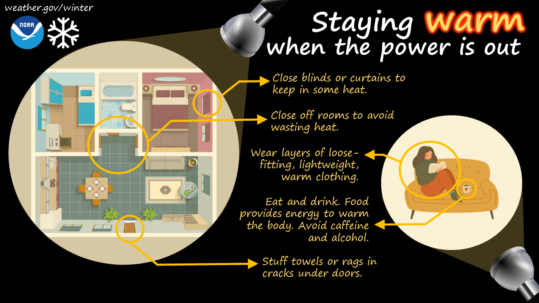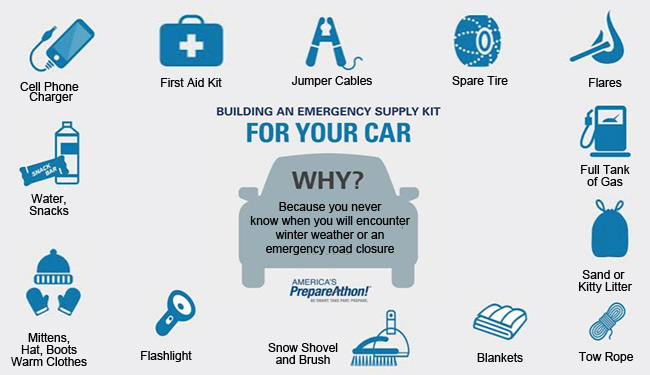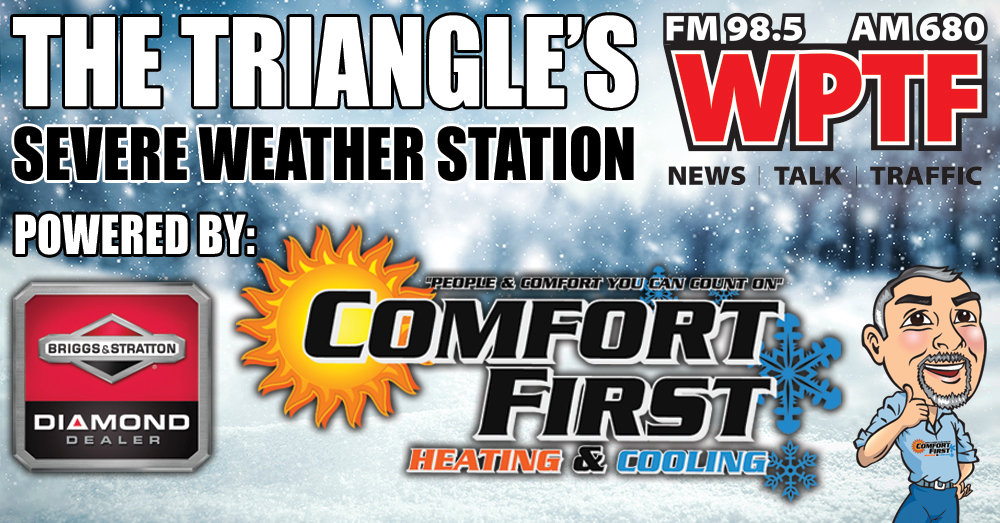Being Prepared for the Winter Season
Winter storms can bring snow, sleet, and freezing rain across the entire United States and its territories. Thousands of people are injured or killed every year in traffic accidents related to slippery roads from winter storms.
Prepare: Winter Weather Warnings
Winter Weather-Related Warnings, Watches, and Advisories are issued by your local National Weather Service office. Each office knows the local area and will issue Warnings, Watches, or Advisories based on local criteria.
- Blizzard Warnings are issued for frequent gusts greater than or equal to 35 mph accompanied by falling and/or blowing snow, frequently reducing visibility to less than 1/4 mile for three hours or more. Do not travel. If you must travel, have a winter survival kit with you. If you get stranded, stay with your vehicle and wait for help to arrive.
- Winter Storm Warnings are issued for a significant winter weather event including snow, ice, sleet, blowing snow, or a combination of these hazards. Travel will become difficult or impossible in some situations. Delay your travel plans until conditions improve.
- Ice Storm Warnings are usually issued for ice accumulation of around 1/4 inch or more. This amount of ice accumulation will make travel dangerous or impossible and likely lead to snapped power lines and falling tree branches. Travel is strongly discouraged.
- Wind Chill Warnings are issued for a combination of very cold air and strong winds that will create dangerously low wind chill values. This level of wind chill will result in frostbite and lead to hypothermia if precautions are not taken. Avoid going outdoors and wear warm protective clothing if you must venture outside.
Plan: What to Do During a Winter Storm?
When caught in a winter storm, there are life-saving actions you can take to protect yourself outside, in a vehicle, and inside your home or office.
If You Are Outside:
- Find Shelter: Try to stay dry and cover all exposed body parts. If there is no shelter, build a lean-to, windbreak, or snow cave for protection from the wind. Build a fire for heat and to attract attention. Place rocks around the fire to absorb and reflect heat.
- Melt Snow for Drinking Water: Eating unmelted snow will lower your body temperature.
- Exercise: From time to time, move arms, legs, fingers, and toes vigorously to keep blood circulating and to keep warm.
If You Are In Your Car:
- Slow Down! Even if the roads just look wet they could still be slick. More than 5,000 fatalities occur on the roadways each year due to weather conditions.
- Make Sure Your Vehicle is Completely Clear of Ice or Snow Before Driving Your Car. Flying ice and snow from cars causes accidents.
- If You Have Trouble Seeing Due to Weather Conditions, Pull Over to the Side of the Road and Stop Your Car Until Visibility Improves. Turn off your lights and use your parking brake when stopped so that another car won’t mistakenly follow your tail/brake lights and end up hitting you.
If You Are Inside:
- Stay Inside: When using heat from a fireplace, wood stove, space heater, etc., use fire safeguards and properly ventilate. If you have a gas furnace, make sure it is not blocked by a snowdrift as soon as it is safe to go outside. If you have an upstairs gas furnace that vents out the roof, you may need to turn off the upstairs unit until the snow melts off your roof.
If Your Heat Goes Out:
- Close off unneeded rooms to avoid wasting heat.
- Stuff towels or rags in cracks under doors.
- Close blinds or curtains to keep in some heat.
- Eat and drink. Food provides the body with energy for producing its own heat. Drinks lots of water and other non-caffeinated, non-alcoholic drinks to prevent dehydration. Cold air is very dry.
- Wear layers of loose-fitting, lightweight, warm clothing. Remove layers to avoid overheating, perspiration, and subsequent chill.
- Follow your local government website and social media channels for sheltering information if it becomes too cold to stay in your home.
- Shelters may not offer cots for sleeping, only safe refuge until a storm passes. Plan to bring your own amenities like food and bedding.

Stay Informed: Who Has Reliable Information?
- Visit weather.gov to learn about local hazards that could impact your area.
- Register for emergency alerts from your local government.
- Follow the NWS social media channels for updates.
- Subscribe to National Weather Service for updates.
Make an Emergency Supply Kit

Prepare for the storm by creating an Emergency Supply Kit or making an emergency plan. Make sure all family members know where the kit is kept. In case you are stranded, keep a kit of emergency supplies in your car.
Some Items to Prepare are:
- Flashlights and Batteries
- Food and Water: Extra food and water such as dried fruit, nuts, granola bars, and other food that does not require cooking or refrigeration.
- Medicines: Extra prescription medicine and over-the-counter medicine. Baby items such as diapers and formula.
- First-Aid Supplies
- Heating Fuel: Fuel carriers may not reach you for days after a severe winter storm. You should also consider an emergency heating source, such as a fireplace, wood stove, space heater, etc. Learn to use your emergency heating source properly to prevent a fire, and be sure to have proper ventilation.
- Blankets and Sleeping Bags
- Shovel and Windshield Scraper or Brush
- Fire Extinguisher and Smoke Alarm: Test smoke alarms monthly to ensure they work properly.
- Pets: Extra pet food and warm shelter for pets.
- Review Generator Safety: Never run a generator in an enclosed space.
Keep your gas tank near full to avoid ice in the tank and fuel lines. Try not to travel alone, and be sure to let someone know your travel plans, timetable, and route.
Other Things to Note:
- Make sure your carbon monoxide detector is working correctly and that the outside vent is clear of leaves and debris. During or after the storm, make sure it is cleared of snow.
- Home Fires are common each winter when trying to stay warm. Review ways to keep your home and loved ones safe.
- Learn more on Disaster Kits via weather.gov
More Winter Weather Resources

National Weather Service
Visit weather.gov for information on how to prepare for the storm.
Winter Weather Resources:
- Interactive Snow Tracking
- National Weather Service Winter Preparedness
- County Emergency Management Agencies and Alerts
Road Closures: Find out about road closures due to ice, snow, or storm damage due to downed trees or power lines at DriveNC.gov.
Power Outage Information: Make sure you have your power company’s phone number so you can call them if your power goes out during or after the storm.
Additional Information
- Red Cross Guides: View a list at redcross.org/shelter.
- FEMA: View a list of helpful guides here.
